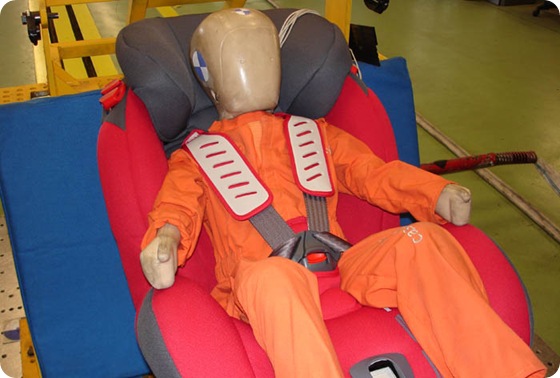Jul 14 2009
The team of researchers from the Applus+ Chair has designed a load limiter that reduces the pressure on the chest area by absorbing part of the energy produced in a frontal impact. The system reduces the speed at which the child is thrown forward and back into the seat, a movement that leads to serious injury in many accidents.
David Gallegos and Paco Liesa, researchers with the Technical University of Catalonia (UPC) Applus+ Automobile Safety Chair, have developed a textile load limiter for child seat belt systems, produced in accordance with the Isofix safety standard. The system absorbs part of the energy produced in a frontal collision, which reduces the risk of serious injury to the child, particularly in the chest area and neck.
The aim of the research project was to create a textile device that, when incorporated into the upper part of an existing seat belt system, would reduce by 50% the time during which the child is subjected to strong forces in the event of a frontal impact. The device reduces the acceleration produced in the same way as a load limiter installed in a standard seat belt system for adults.
The textile device consists of a series of folds sown into the upper part of the harness, which is the area that transmits the force of an impact to the anchoring points of the vehicle.
The decisive step in the design of new child retention systems was the development of a mechanism for extending the harness without increasing the risk of the child coming into contact with structural elements of the vehicle.
Despite its comparatively simple appearance, this new innovation is the product of a complex series of static and dynamic tests and electron microscopic analyses. The system is cheap to install, does not require additional components to be connected to the existing seat belt system, and does not affect the installation of a child seat or the way in which the child must be positioned.
Although systems of this type are widely available, 18% of child passengers in Barcelona and its area of influence do not travel with any type of child seat belt mechanism fitted. When three or more children are travelling in the same vehicle, this figure increases to 45%.
According to a preliminary study carried out by Applus+ Chair researchers, most new car models are fitted with the Isofix standard, which provides rigid attachment points between the chassis and the child seat that can be fixed easily to the child seat belt system. Therefore, research into new systems and mechanisms for increasing child car safety must take into account this anchoring standard.
An award-winning system
The project won the Mª Àngels Jiménez Barcelona Memorial Prize for Road Safety for the best university research project in this field, awarded by the Barcelona City Council, the Royal Automobile Club of Catalonia (RACC), AXA, and the Spanish Association for the Prevention of Traffic Accidents (PAT). The researchers were also finalists at the International Technical Conference on the Enhanced Safety of Vehicles, which holds an international competition between university research projects in the field of automobile safety.